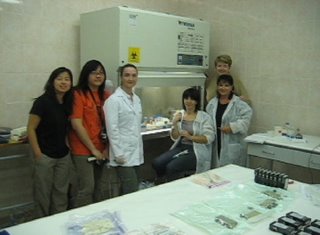Baikonour, We Have Lift Off!
 The culmination of our work catapulted into space today. This day began at 4am. After 2 long days of work finishing with the hand-off of the packaged hardware at 8pm the night before, fatigue was showing on everyone's face. We made a pact to wake each other in the morning as we weren't confident that even our excitement for the launch would get us up once we fall into sleep.
The culmination of our work catapulted into space today. This day began at 4am. After 2 long days of work finishing with the hand-off of the packaged hardware at 8pm the night before, fatigue was showing on everyone's face. We made a pact to wake each other in the morning as we weren't confident that even our excitement for the launch would get us up once we fall into sleep.We were in for a special treat. We were going to meet the 3 cosmonauts in a small send-off ceremony before the launch. There were no more than a hundred people in the conference hall. The cosmonauts have been quarantined for days already as a safety measure to prevent the spread of infection in space. They sat separated from the crowd behind a glass barrier. All personnel behind the glass wall with them were wearing face masks and sterile gowns. The cosmonauts were already in the full get-up of their spacesuites and spoke to us through microphones across the glass. Anousheh Ansari, the first female space participant, looked radiant as she thanked everyone for helping her achieve her dream. She looked as if she couldn't wait to get to the launch pad. Miguel Lopez-Alegria, the American astronaut, was calm and smiled gently. The Russian cosmonaut Mikhail Tyurin's young son, no more than 6-years-old, went right up to the glass wall to say goodbye. He was obviously so proud and in awe of his father in his spacesuite. Likewise, the glass wall was no barrier to the love Tyurin had in his eyes for his boy.
The delegation then moved outside the building. In the dim light of sunrise, standing well away from them, we watched the cosmonauts board the vehicle that would take them to Gagarin's Launch Pad, named after him because it was the pad used to launch the first manned spaceflight.
We had a quick breakfast before heading for the launch viewing platform only 600m away from the launch pad. We were there early enough to get front row standing room right against the railing. The platform soon filled up with family, friends, all the ground support crew, and the press. There were still 30 minutes before the precise launch time of 10:08am, calculated so that the Soyuz would meet the space station orbit. Periodically, loudspeakers around us boomed out announcements in Russian and these became more frequent as the launch time approached. We positioned our cameras and camcorders to capture the moment we've all been waiting for and felt our hearts beat a bit faster with each ticking second. There was no countdown over the loudspeakers, but at the precise designated time we saw the gantry fall away. A plume of smoke eminated from below the rocket and this became ablaze. The huge fireball lifted the rocket straight up into the clear blue sky. We, on the platform, felt the vibration and heard the roar of the launch. The power that was propelling 3 human beings into space was awesome. The rocket quickly became only a fiery dot in the sky and out of sight. The loudspeakers reported that all systems were normal and, moments later, that the Soyuz had successfully entered orbit. Only then, as with tradition, did people break out in applause, cheers, and congratulations for a truly beautiful launch.
We were invited to the official celebratory party in a large reception hall filled with good food. There were many speeches and hurrahs, many toasts with cognac and vodka. Everyone was in high spirits, more from the picture perfect launch than the alcohol. The party was especially fun for us when it became a lively trade and exchange of Energia and NASA issued pins. Millie, Chai-Fei, and I made off quite well with our acquisitions.
After the party, we picked up our personal luggage as well as all the lab equipment and supplies to bring back. Exhaustion was starting to set in but we still had a lot of traveling to do. Our plane would leave Baikonour at 6pm and we wouldn't reach our Moscow hotel until midnight.
I looked back while walking up the steps to board our plane and saw one of the many Baikonour launch pads in the distance. The clouds were just starting to break after a short burst of rain. As our plane took off over the flat barren desert, the sun broke through, lit up the launch pad like spotlight and cast an arcing rainbow over it. There was no better statement than that image for all we saw, did, and experienced that day.
In 10 days, the Soyuz will return somewhere in the northern Kazakhstan desert. Our samples will be on board and make their way back to San Francisco. Months and months of experimental analysis will follow. But for now, our experiment is in the hands of the cosmonauts and astronauts aboard the International Space Station.








